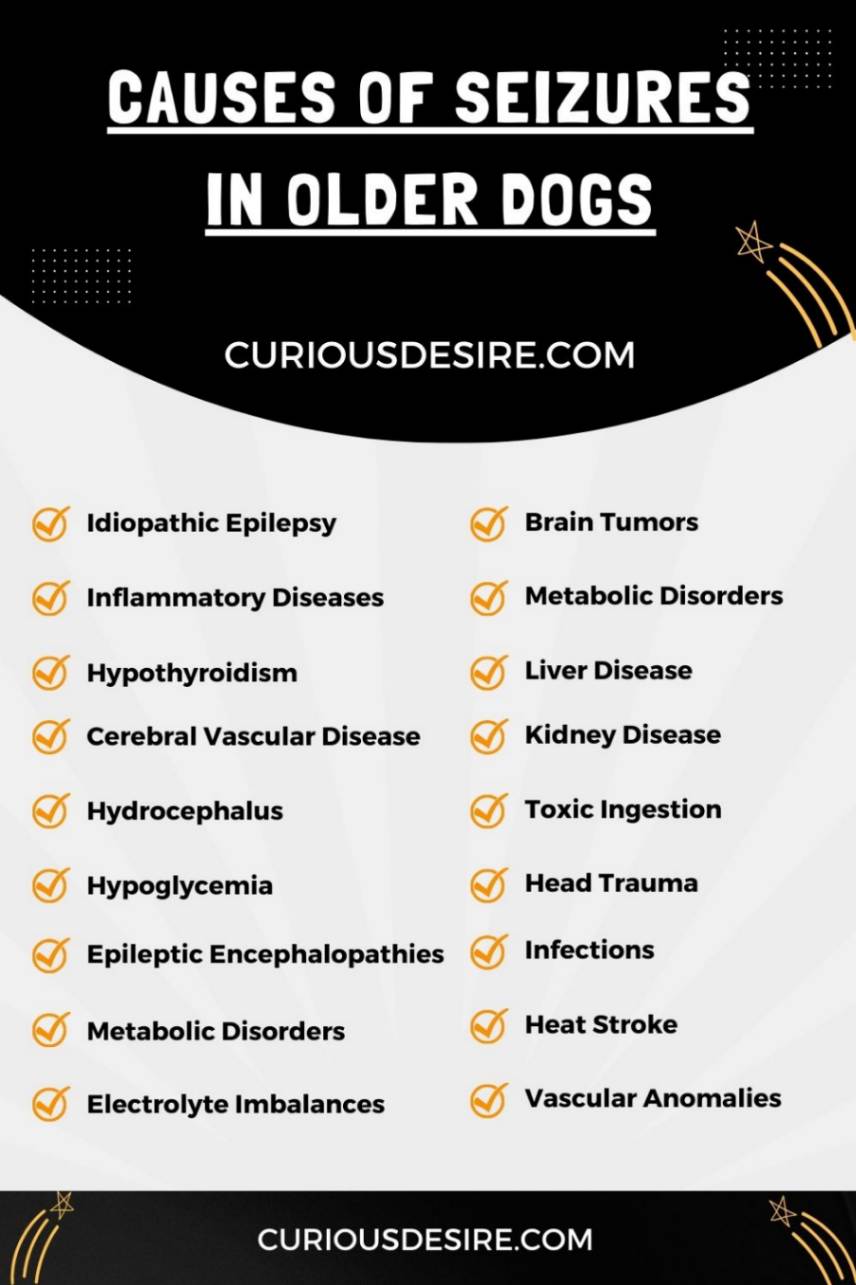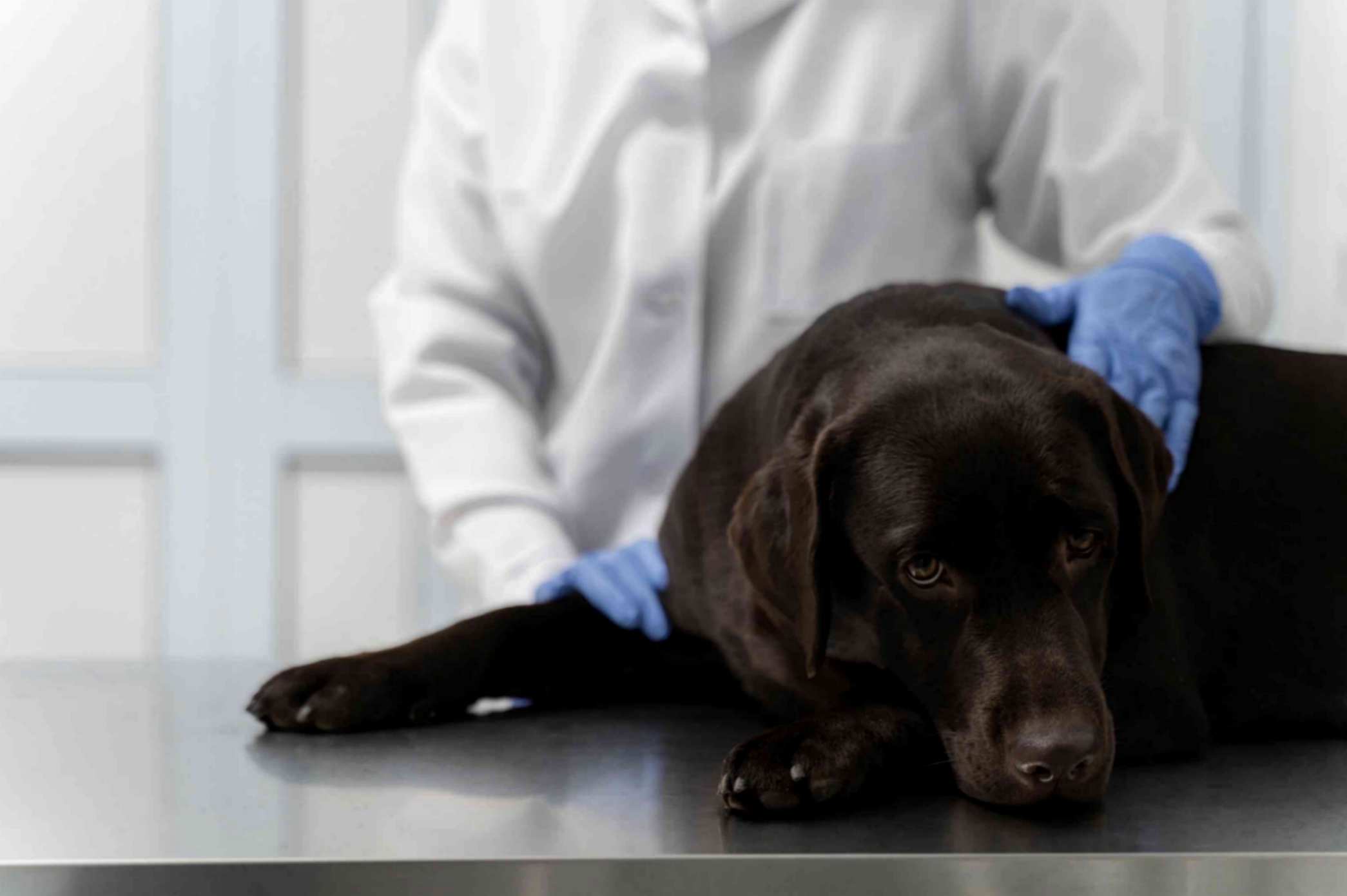1. Idiopathic Epilepsy
Idiopathic epilepsy is a type of seizure disorder in older dogs that has no clear underlying cause. It is believed to have a genetic component, and certain breeds may be more predisposed.
Dogs with idiopathic epilepsy may experience recurrent seizures without any apparent trigger. These seizures can manifest as sudden convulsions, loss of consciousness, and uncontrolled movements.
For example, suppose your older Labrador suddenly starts shaking, falls to the ground, and experiences uncontrollable jerking. After a few minutes, your dog may seem disoriented or tired. This could be a sign of idiopathic epilepsy.
Consult your veterinarian if you suspect your dog has idiopathic epilepsy. They may conduct tests to rule out other potential causes. Treatment often involves medication, such as antiepileptic drugs, to manage and reduce the frequency of seizures.
2. Brain Tumors
Brain tumors in older dogs happen when abnormal cells grow in their brain. It’s like having a lump that shouldn’t be there. Dogs with brain tumors might act strangely, have seizures, or show changes in behavior.
For instance, picture your older dog acting confused, having trouble walking, or having unexpected seizures. These signs could point to a brain tumor.
Visit your vet if you notice strange behavior in your dog. They’ll do tests to check for a brain tumor. Treatment options may include surgery, medication, or other therapies, depending on the situation.
3. Inflammatory Brain Diseases
4. Metabolic Disorders
Metabolic disorders in older dogs occur when the body’s internal systems, such as sugar levels, electrolytes, or liver function, fall out of balance. It’s like the body’s intricate machinery experiencing a hiccup.
For instance, imagine your older dog seeming unusually fatigued, struggling with mobility, or just not appearing well. These signs could point to disruptions in metabolic balance.
Treatment approaches may include tailored diets, medications, or other interventions to restore balance. Regular veterinary check-ups are vital to monitor your dog’s health and ensure that their metabolic systems are functioning optimally.
5. Hypothyroidism
Hypothyroidism in older dogs happens when the thyroid gland doesn’t produce enough hormones. It’s like a slowdown in the body’s engine, affecting various functions.
Dogs with hypothyroidism might exhibit signs such as weight gain, lethargy, or changes in their coat quality. It’s like the body is running on low energy and not maintaining itself as it should.
Regular veterinary follow-ups are important to monitor thyroid hormone levels and ensure your dog’s overall well-being. Early detection and appropriate management can help your furry companion lead a healthier and more active life.
6. Liver Disease
Liver disease in dogs occurs when the liver, a vital organ responsible for various essential functions, encounters difficulties in its normal operation.
These challenges may arise from infections, exposure to toxins, or the natural aging process, leading to compromised liver function.
Imagine your older dog with jaundiced yellow eyes or skin, frequent episodes of vomiting, and a noticeable decrease in appetite. These observable signs could indicate that the liver is grappling with disruptions in its usual functioning.
Seeking veterinary attention quickly is important if you observe concerning symptoms. The vet may recommend specialized diets, medications, or interventions to support and enhance liver function.
7. Kidney Disease
Kidney disease in dogs arises when the intricate filtration system provided by the kidneys faces challenges. Aging, infections, or genetic factors may contribute to a decline in kidney function, impacting the body’s ability to regulate fluids and eliminate waste effectively.
For example, picture your older dog displaying increased thirst, frequent trips to the bathroom, and an unexplained loss of weight.
These observable changes might suggest that their kidneys are struggling to maintain the necessary balance in the body’s internal environment.
Diagnostic tests will be conducted to confirm the condition, and a treatment plan may involve specialized diets, medications, and strategies to manage hydration.
8. Toxic Ingestion
Toxic ingestion in dogs occurs when they consume substances that can be harmful to their health.
This can range from ingesting certain plants or chemicals to accidentally consuming medications meant for humans, leading to an imbalance in the body’s normal functioning.
For example, suppose your older dog starts vomiting, experiences diarrhea, and appears unusually tired after being exposed to a particular plant or substance. These overt signs could suggest a case of toxic ingestion.
In situations involving suspected toxic ingestion, immediate veterinary attention is important. Your vet will assess the situation, possibly induce vomiting to expel the harmful substance and provide treatment based on the ingested material.
9. Stroke or Cerebral Vascular Disease
In dogs, a stroke or cerebral vascular disease can lead to seizures due to disruptions in the normal blood flow to the brain.
When there is an interruption in the blood supply, it can cause temporary or permanent damage to the brain cells, triggering abnormal electrical activity and resulting in seizures.
For example, imagine your older dog suddenly experiencing confusion, loss of balance, and unusual movements. These abrupt neurological symptoms could be indicative of a stroke or cerebral vascular disease, potentially leading to seizures.
Treatment may involve managing underlying cardiovascular conditions and providing supportive care to help in recovery. While addressing the root cause is important, managing seizures might involve antiepileptic medications.
10. Head Trauma
Head trauma in dogs can lead to seizures as a result of the physical impact on the brain. The forceful injury can cause the brain to function abnormally, leading to the manifestation of seizures as one of the potential consequences of head trauma.
For instance, picture your older dog experiencing confusion, altered behavior, or even loss of consciousness after a fall or accident.
These overt signs could indicate the possibility of head trauma, which may, in turn, contribute to the occurrence of seizures.
11. Hydrocephalus
Hydrocephalus in dogs occurs when there is an abnormal accumulation of cerebrospinal fluid in the brain, leading to increased pressure. This can happen due to a developmental issue or obstruction in the fluid’s normal flow, causing the brain to swell.
For instance, imagine your puppy having an unusually large head and showing signs of disorientation. These could be indicators of hydrocephalus.
Hydrocephalus can impact a dog’s health by causing neurological issues, leading to symptoms like seizures, difficulty walking, and changes in behavior. It requires careful management by a veterinarian to ensure the well-being of the affected dog.
12. Infections
Infections in dogs can occur when harmful microorganisms like bacteria or viruses enter their body. These invaders can affect various organs, including the brain, leading to conditions such as encephalitis.
Picture your older dog suddenly showing signs of disorientation, seizures, or difficulty coordinating movements. These could be signs of an infection affecting the brain.
Infections impacting the brain can severely affect a dog’s health, causing neurological symptoms and, in some cases, long-term damage.
Timely veterinary intervention is important to identify and treat the specific infection, helping to minimize its impact on the dog’s overall health.
13. Heat Stroke
Heat stroke in dogs occurs when their body temperature rises to a dangerous level due to exposure to excessive heat. Dogs regulate their temperature through panting, and when they can’t cool down effectively, it can lead to heat stroke.
For example, imagine your dog being overly panting, drooling excessively, and appearing lethargic after being in the hot sun. These signs could indicate heat stroke.
Heat stroke can have severe consequences on a dog’s health, including organ damage and, in extreme cases, death. Immediate measures, such as cooling the dog down and seeking veterinary assistance, are vital to prevent long-term health issues.
14. Low Blood Sugar (Hypoglycemia)
Hypoglycemia in dogs occurs when their blood sugar levels drop to abnormally low levels. This can happen due to various reasons, including not eating enough, certain medical conditions, or an insulin overdose in diabetic dogs.
Picture your small breed dog trembling, acting weak, or having seizures, especially if they’ve missed a meal. These could be signs of low blood sugar.
Hypoglycemia can have a significant impact on a dog’s health, leading to weakness, confusion, seizures, and even loss of consciousness.
It requires quick treatment, such as providing a sugary treat or seeking veterinary assistance, to bring the blood sugar levels back to normal and prevent further complications.
15. Epileptic Encephalopathies
Epileptic encephalopathies in dogs happen when continuous or frequent seizures lead to progressive damage to the brain. The constant seizures create a cycle where abnormal brain activity triggers more seizures.
For example, think of your older dog having frequent and intense seizures, causing a decline in cognitive function over time. This could be a sign of epileptic encephalopathies.
Epileptic encephalopathies significantly impact a dog’s health, leading to cognitive decline, behavior changes, and an overall decrease in well-being. Managing these conditions involves medications and supportive care to enhance the dog’s quality of life.
16. Inherited Metabolic Disorders
Inherited metabolic disorders in dogs occur due to genetic factors causing abnormalities in metabolic processes. These abnormalities can affect the brain’s functioning, potentially leading to seizures.
Consider your older dog having unexplained seizures along with other signs like developmental delays or abnormal behaviors. This could be a sign of an inherited metabolic disorder.
Inherited metabolic disorders can profoundly impact a dog’s health, affecting various organ systems, including the brain.
Managing these conditions involves special diets, medications, and sometimes supportive therapies to address metabolic imbalances and minimize seizures.
17. Vascular Anomalies
Vascular anomalies in dogs refer to abnormal blood vessel formations. When these anomalies happen in the brain, they can disrupt normal blood flow, leading to oxygen deprivation and triggering seizures.
For instance, your older dog has sudden seizures, potentially linked to specific head movements or positions. This could be a sign of a vascular anomaly affecting blood flow to the brain.
Treatment may involve interventions to manage the vascular anomaly and prevent further complications, focusing on improving overall blood flow to the brain.
18. Electrolyte Imbalances
Electrolyte imbalances in dogs occur when there are disruptions in the levels of essential minerals like sodium, potassium, or calcium. These imbalances can affect the electrical activity in the brain, potentially leading to seizures.
For example, picture your older dog having seizures after a bout of vomiting or diarrhea. This could be a sign of electrolyte imbalances, where the loss of essential minerals triggers abnormal brain activity.
Treatment involves addressing the underlying cause of the imbalance, providing supportive care, and ensuring proper hydration to restore and maintain the necessary electrolyte balance.



